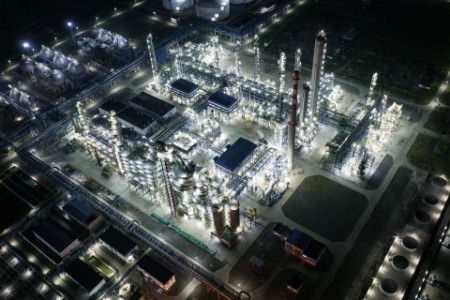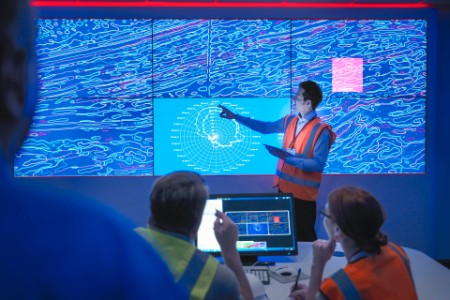
Chapter 1
Talent crisis in the energy sector
Between an aging workforce on the one hand, and a lack of suitable new hires on the other, the oil and gas industry is facing a talent squeeze.
The oil and gas bonanza of the 1970s saw demand for skilled workers explode. Today, it’s a different story. A recent report from the Society of Petroleum Engineers, a global industry organization, found that nearly 54% of its members are over 55 years old. And as that generation of workers retires, they aren’t being replaced by younger employees.
The industry itself is also rapidly changing. The economic slowdown and low oil prices from 2014 resulted in a loss of nearly 450,000 industry jobs by early 2017 as investment was scaled back — and with every job lost, a lifetime of experience and knowledge goes with it.
In addition, decommissioning aging assets is now a $160b high-tech global remediation and recycling market — which is creating demand for new skill sets.
New hires are clearly needed, but they are proving elusive. Our survey found that 44% of Generation Y and 62% of Generation Z say a career in oil and gas is unappealing, while two out of three teens say the oil and gas industry creates more problems than it solves. More than 70% of millennials and Gen-Z think the industry is dangerous.
Additionally, 81% of the industry’s executives agree that the industry will need to develop a better-educated, highly skilled workforce over the next 10 years. New, technologically advanced extraction methods enabled by digitalization are fast advancing — requiring new skillsets as well as new equipment.
This means the oil and gas talent crisis is a two-sided coin: the exit of older workers and their experience and the inability to find new hires to replace them.

Chapter 2
AI to the rescue
AI may have a critical role to play in helping the oil and gas industry resolve its talent and experience issues.
AI has the potential to address the oil and gas industry’s core talent challenges in three ways. First, by making existing oil and gas operations more efficient, so less resources are needed to maintain them. Second, by codifying some of the knowledge of retiring engineers into virtual agents. Thirdly, by making the industry more attractive to younger hires.
1. Reducing the impact of the brain drain
Before more workers retire, it’s vital to capture their institutional knowledge to retain key insights and experience. AI and advanced technologies can also be used to preserve the expertise of retiring generations in ways that can actually increase its impact.
Intuitive AI-enabled information retrieval systems, which capture text and voice inputs and use natural language processing, can already be built to collate retirees’ knowledge and experience in ways that can be tapped into by any member of staff. These could include apps to help less experienced workers identify specialist parts onsite, or even answer questions in the head office using pooled, interrogable chat bot-style databases, solving problems with the uncanny ease of a science fiction computer. These systems can also be used to for onboarding and passing on critical business knowledge to new hires, forging a link between generations, achieving business continuity.
At the same time, at the forefront of AI’s utility is its ability to automate previously human-operated and time-consuming functions. This will help lessen the impact of workers taking their skills with them into retirement. After all, if you can automate a job function, the institutional knowledge about that particular role is no longer necessary for the organization to function.
In the field, AI can identify the need for repairs and infrastructure updates to help target investment and effort more effectively. For example, drones use a combination of on-board (edge) AI and cloud-based AI, along with GPS, to navigate, avoid collision and execute tasks in the field, including surveying and capturing imagery. They can fly over hazardous or uncharted land or even work underwater to send back real-time reports from inspection points, making work safer for humans, while also amplifying human productivity.
The wider ecosystem of oil and gas infrastructure may also benefit from AI. With so many facilities, plants and refineries built half a century ago, frequently with little or no computer integration, the industry has significant technical debt. It must first upgrade from analogue to digital systems that layer intelligent and autonomous systems on top of this newly connected infrastructure. As equipment and sites reach the end of their lifespan, the industry faces years of upgrade investments necessary to remain competitive and profitable.
2. Making the industry more attractive to new hires
Part of this solution goes hand-in-hand with the first – by automating lots of the dirty, on-the-ground work that the industry is known for, it can help create a less dangerous, less environmentally impactful and more attractive workplace.
As many as 70% of millennials believe jobs in oil and gas are physically demanding. This is a potential barrier to entry that AI can help lower by reducing the hands-on parts of the business.
In addition, the work that remains will be more attractive to younger hires. A fresh emphasis on pioneering technology could make oil and gas an aspirational career choice for a new generation of recruits whose interests lie more in the technology and coding spheres. In an analysis of job-seeker click behaviour, younger applicants were far more likely to click on jobs with a digital element, such as developers and data scientists.
Instead, roles of the future will focus more on oversight, compliance as well as the training, implementation and management of AI systems. This means they will involve a much greater emphasis on flexibility and digital capabilities and using new technologies to further transform the industry into one that’s fit for the future.
Only 36% of Generation Z and 50% of Generation Y believe the oil and gas industry has a positive impact on local and global communities. This potential to radically change how the industry operates — while helping to contribute to global economic growth — could prove a challenge capable of winning over new generations to the industry’s positive potential.

Chapter 3
Toward a new value ecosystem
The effects of an AI-based approach to resolve talent issues will have far-reaching implications.
The sort of radical technology shift the oil and gas industry needs won’t emerge from a vacuum. But the call for these technologies will create fresh demand for a new supply chain — designed for, and in collaboration with, the workers who will end up using it. New products, services, companies and skilled roles will emerge, which will provide the means for the industry to grow.
Following that, a new, AI-enabled approach will also transform the way the oil and gas industry works as an ecosystem inspiring a new art of the possible and, along with it, new ways of operating and growing the business. This could include partnerships or joint ventures between industry players and technology firms, for example. Or it could mean the creation of open data ecosystems, where data can be shared between divisions, unlocking new stores of value. Data could possibly even be shared by external parties, like start-ups looking to build innovative and value-added services for the industry.
And this transformation of the structure of the industry may in turn generate exciting new roles, like a drilling data scientist, an IoT platform engineer or a rig automation supervisor. It could even create whole new industries, jobs, and opportunities for early investors as well as bring a new reputation for oil and gas as being on the leading edge of innovation that will attract leading talent.
Summary
The oil and gas industry is facing a brain drain, as older generations and their expertise leave, and younger hires move away from the sector, seeing it as dangerous and old-fashioned. AI can help address these trends by automating key tasks, preserving institutional knowledge, and promoting the growth of technological roles.


